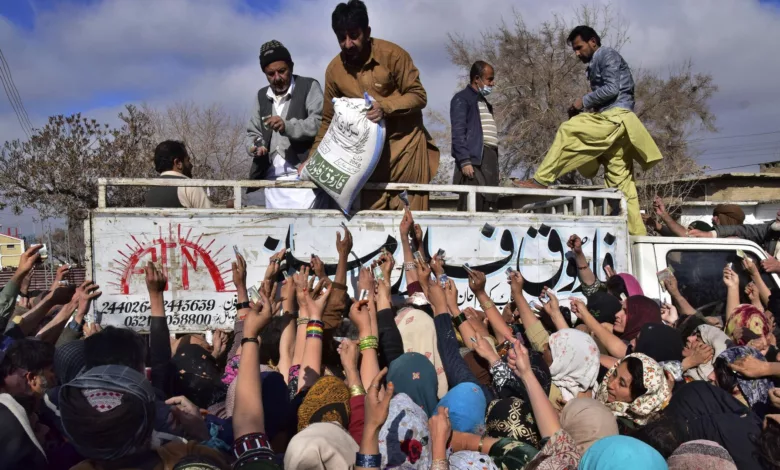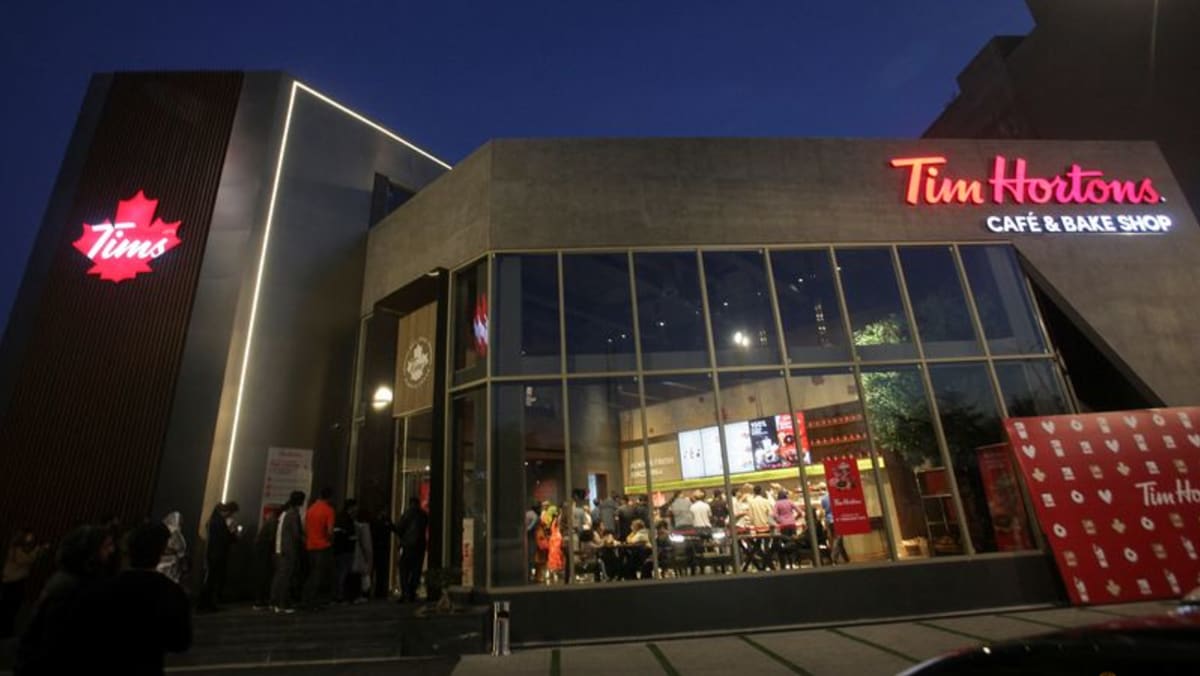Pakistan’s People Stand Hours-Long In Tim Hortons Line For Coffee Amid Economic Crisis
According to some Twitter users, more than 25 percent of Pakistan's population was struggling to make ends meet while the remainder helped Tim Hortons set sales records.

This week, hundreds of people were observed waiting to buy food as Pakistan‘s socioeconomic problems continue to worsen. But in a pretty bleak contrast, some people spent hundreds of rupees on coffee while others were ready to buy necessities like wheat. According to some Twitter users, more than 25 percent of Pakistan’s population was struggling to make ends meet while the remainder helped Tim Hortons set sales records.
Following the opening of the first location in Pakistan on Saturday, Pakistanis were seen waiting in line for hours to get coffee and pastries from the Canadian bakery business. A small brewed coffee costs 350 rupees, but a big flavored coffee costs twice as much, according to the restaurant’s web menu To put issues into perspective, the average government-mandated minimum wage is ₹25,000 rupees per month.
“Tim Horton‘s first day of sales in Pakistan set a new global record for sales volume. One Twitter user bemoaned, “The world must be laughing at us. We are on the verge of default, and our people are starving to death .but let’s enjoy an exorbitant cup of ordinary-tasting coffee.”
Two Sides Of Pakistan
Others discussed the “two sides of Pakistan,” pointing out that many people were also waiting in line at flour stores at all hours of the day to stock up on necessities. Pakistanis have experienced wheat shortages in recent weeks, which have even resulted in fatalities as hundreds of people lined up for the few supplies.
According to reports, a stampede that started in the Sindh district in January claimed the life of a father of six children. People have been forced to wait in large lines at specific retailers to purchase subsidized flour as prices have reached record highs.

“The class of individuals coming here doesn’t care if the prices are higher. Pakistan’s middle class is struggling as the rich are getting richer and the poor are getting poorer “As he waited in line at the Tim Hortons location, Ahmad Javed told. When the medical student lived in Canada, he frequently visited Tim Hortons.
“I’m here to sample the popular coffee on social media. I’m not sure, but the value of Pakistan’s currency relative to the US dollar has dropped by more than a quarter in less than a month. As the government completed the budgetary reforms necessary to access funding from a bailout from the International Monetary Fund, fuel costs increased by over a fifth. I don’t care about the price, either,” another youngster told the newspaper. The government only has enough foreign reserves to cover just more than three weeks’ worth of imports, and inflation rose to its highest level in more than a decade in January.
In Pakistan, inflation could average 33% in the first half of 2023 before moving lower, according to a Moody’s update that Reuters shared. As things stand, a rescue from the International Monetary Fund might not be sufficient to restart the economy. “Persistent and prudent economic management is what the economy needs. There is still a difficult journey in front of us. Senior economist Katrina Ell predicted that fiscal and monetary austerity will last well into 2024.
Economic Crisis Of Pakistan
The economy of Pakistan is struggling, and it is taking some desperate measures to prevent a collapse. The issue is so severe that the country has put its embassy property in Washington up for sale and ordered markets, restaurants, wedding venues, and shopping centers to close early and to conserve electricity, which is primarily produced by imported oil.
While the country’s economy has not been in a good form for the last few years, the problem has been exacerbated lately due to a mix of causes like faltering GDP growth, rising global inflation due to Ukraine war, sinking currency making the imports pricier, and pulling down the forex reserves. Less money is available to pay debts due to lower economic growth.

Aside from economic factors, 33 million people were harmed by an enormous flood that ravaged Pakistan and caused extensive damage. According to the World Bank’s assessment statement, which was issued on October 28, 2022, the flood-related damages and economic losses were expected to total more than $30 billion ($14.9 billion in damages and $ 15.2 billion in economic losses).
Forex Reserves in Pakistan
The majority of Pakistan’s oil needs are imported. Nearly all central banks rushed to raise interest rates as global inflation shot through the roof. This put pressure on the world’s currencies, which therefore declined dramatically to about the US dollar. Foreign reserves were further drained as a result of import prices rising due to the currency’s depreciation. The lowest in eight years and hardly enough to cover one month of imports, Pakistan’s foreign exchange reserves in December 2022 dropped to below 6 billion dollars.
GDP Growth in Pakistan
The World Bank predicted in October that Pakistan’s economic growth would only be about 2% in FY23. The global organization project sits 23% inflation in the current fiscal year due to increasing energy prices, a weaker rupee, and agricultural production interruptions brought on by floods, in addition to the nation’s poor economic growth. The Pakistan Bureau of Statistics reports that Pakistan had record-breaking inflation in December of 24.5%.
Pakistan’s Debt
In its recently released annual report on debt, the World Bank anticipated that Pakistan’s total external debt will reach $130.433 billion by 2021. By FY 2023, the nation must pay $33 billion in obligations. In a podcast on December 8, the governor of the State Bank of Pakistan, Jameel Ahmad, stated that while $20 billion had been accounted for, the remaining $13 billion of the fiscal year still needed to be managed by the nation.

IMF’s Bailout Package
Pakistan obtained a $6 billion bailout assistance from the IMF in 2019. (International Monetary Fund). The international banking organization provided $3.9 billion in desperately needed funding until August of last year. The seventh and eighth evaluations were finished on August 29, 2022, and Pakistan was permitted to withdraw $1.1 billion. Because of an ongoing review, the subsequent tranche missed its target delivery date of September (IMF conducts a regular review to check how its bailout money is being spent). Pakistan is in severe need of the most recent infusion of $1.18 billion.
Pakistan was on the verge of a debt default, claimed Steve Hanke, a professor of applied economics at Johns Hopkins University, in a tweet on October 14, 2013. According to him, its sovereign bonds lost more than 60% of their value in 2022.
Pakistan’s Economy: IMF
In a note published in August, the IMF stated that Pakistan was experiencing a severe economic crossroads as a result of a challenging external environment and procyclical domestic policies that raised domestic demand to unsustainable levels. The ensuing economic overheating reduced reserve buffers, increased inflation, and resulted in significant fiscal and external deficits in FY22. “
A balance-of-payments crisis is what economists refer to as occurring in Pakistan. The nation has been depleting its reserve of foreign currency and depreciating the value of the rupee by spending more on commerce than it has been bringing in. These factors increase the cost of paying interest on debt held by foreign lenders and raise the price of importing goods, necessitating further drawdowns of reserves that worsen the situation.

The nation is also battling escalating price rises. To combat annual consumer inflation of around 28%, the nation’s central bank increased its benchmark interest rate to 17%. Pakistan-specific challenges also exist in the nation. According to Tahir Abbas, head of investment research at Arif Habib, the nation’s largest securities brokerage, political instability and efforts to support its currency, for instance, have hurt investment and exports.
The government budget is now more strained as a result of the historic floods that occurred last summer. According to the World Bank, it will need at least $16 billion to cover losses and damage. However, external factors are deteriorating the situation. The decline in global demand has hurt Pakistan’s exports, and last year’s strong increase in the value of the US dollar put pressure on nations that import a lot of food and fuel. Due to the pandemic and Russia’s conflict in Ukraine, prices for these commodities had already risen sharply, necessitating greater expenditures.
The IMF has often issued warnings that this might put a strain on fragile economies. The ability to manage debt loads continues to be a problem, despite the projection that emerging markets and developing economies would experience a moderate rise in GDP this year as the currency drops from its highs, global inflation declines, and China’s reopening boosts demand.
Meanwhile, people are suffering. Rice, cotton, dates, sugar, and other crops destroyed by flooding are still in need of assistance. Without “decisive relief and rehabilitation initiatives to support the poor,” the World Bank warned in October that up to nine million Pakistanis might be driven into poverty.
edited and proofread by nikita sharma



